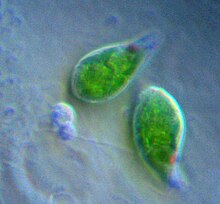| Euglenozoa | |
|---|---|

| |
| Two Euglena | |
| Scientific classification | |
| Domain: | Eukaryota |
| Superphylum: | Discicristata |
| Phylum: | Euglenozoa Cavalier-Smith, 1981[2] |
| Classes | |
| |
The Euglenozoa are a large phylum of flagellate protists. They are part of the wastebasket taxon known as the Protozoa, which had many obviously different protists.
Euglenozoa include a variety of common free-living species, and some important parasites, of which a few infect humans. There are two main subgroups, the Euglenoidea "euglenids" and Kinetoplastea "kinetoplastids".[3] Euglenozoa are unicellular, mostly around 15–40 µm in size, although some euglenids get up to 500 µm long.
Most Euglenozoa have two flagella, parallel to one another in a pocket-like structure. In some there is a cytostome or mouth, used to eat bacteria or other small organisms. This is supported by a microtubule from the flagellar bases; two other tubules support the dorsal and ventral surfaces of the cell.[4]
Some other Euglenozoa feed through absorption, and many euglenids have chloroplasts and so get energy by photosynthesis. These chloroplasts are surrounded by three membranes and contain chlorophylls A and C, and other pigments,[3] so are probably evolved from those of a captured green alga. Reproduction occurs only by cell division. During mitosis, the nuclear membrane remains intact, and the spindle microtubules form inside it.[4]
The group is characterized by the ultrastructure of the flagella. In addition to the normal supporting microtubules, each contains a rod (called paraxonemal), which has a tubular structure in one flagellum and a latticed structure in the other.[5]
Classification
[change | change source]The euglenozoa are generally accepted as monophyletic. They are related to Percolozoa. The two share mitochondria with disk-shaped compartments, which only occurs in a few other groups.[6] Both probably belong to a larger group of eukaryotes called the Excavata.[7] This grouping has been challenged.[8]
References
[change | change source]- ↑ Zakryś, B; Milanowski, R; Karnkowska, Anna (2017). "Evolutionary Origin of Euglena". Euglena: Biochemistry, Cell and Molecular Biology. Advances in Experimental Medicine and Biology. Vol. 979. pp. 3–17. doi:10.1007/978-3-319-54910-1_1. ISBN 978-3-319-54908-8. PMID 28429314.
- ↑ Cavalier-Smith T (1981). "Eukaryote kingdoms: seven or nine?". Bio Systems. 14 (3–4): 461–481. doi:10.1016/0303-2647(81)90050-2. PMID 7337818.
- ↑ 3.0 3.1
Cavalier-Smith T. 1981. (1981). "Eukaryote kingdoms: seven or nine?". BioSystems. 14 (3–4): 461–481. doi:10.1016/0303-2647(81)90050-2. PMID 7337818.
((cite journal)): CS1 maint: numeric names: authors list (link) - ↑ 4.0 4.1 Patterson, David J. 1999. (1999). "The diversity of eukaryotes". American Naturalist. 154 (S4): S96–S124. doi:10.1086/303287. PMID 10527921. S2CID 4367158.
((cite journal)): CS1 maint: numeric names: authors list (link) - ↑
Simpson A.G.B. 1997. (1997). "The identity and composition of Euglenozoa". Archiv für Protistenkunde. 148 (3): 318–328. doi:10.1016/S0003-9365(97)80012-7.
((cite journal)): CS1 maint: numeric names: authors list (link) - ↑ Baldauf S.L; Roger A.J; Wenk-Siefert I. & Doolittle, W. Ford 2000. A Kingdom-level phylogeny of eukaryotes based on combined protein data. Science 290 (5493): 972–977. [1]
- ↑
Simpson, Alastair G. 2003. (2003). "Cytoskeletal organization, phylogenetic affinities and systematics in the contentious taxon Excavata (Eukaryota)". International Journal of Systematic and Evolutionary Microbiology. 53 (Pt 6): 1759–1777. doi:10.1099/ijs.0.02578-0. PMID 14657103.
((cite journal)): CS1 maint: numeric names: authors list (link) - ↑ Cavalier-Smith T 2009. Kingdoms Protozoa and Chromista and the eozoan root of the eukaryotic tree (2010). "Kingdoms Protozoa and Chromista and the eozoan root of the eukaryotic tree". Biol Lett. 6 (3): 342–5. doi:10.1098/rsbl.2009.0948. PMC 2880060. PMID 20031978. Archived from the original on 2020-05-20. Retrieved 2013-01-22.
((cite journal)): CS1 maint: numeric names: authors list (link)